Almost a Professional Photographer
- briggsmroz
- Dec 11, 2019
- 6 min read
Updated: Dec 12, 2019
I am at 崁頂國小to teach English, and yet I found myself at a county level singing competition this Tuesday as 崁頂國小’s photographer. I had gone with the school’s drumming group to Taipei and the sixth-grade teacher really liked my pictures, all 300 of the ones I thought good enough to show (I took what felt like 1,000 pictures in the drumming parade before). That’s how my LET and I found out that on Tuesday we would be going to Taitung city with the kids to act as the photographer and the videographer of the event instead of teaching classes. I was pretty excited to get another chance to hear them sing and not having to plan a first-grade lesson plan was an added bonus.

I was all geared up with my camera, multiple batteries, all my memory cards, and of course two different lens. We left school in a large tour bus at 8:10, embarking on an hour ride trip to the city. I am pretty sure everyone, students and other teachers alike, were all asleep on the way down to the city it was so quiet.

As with most events I go to with my school, I really had no clue what I was getting into. We showed up at the Taitung County center for Culture and Arts to see hoards of children in traditional clothing. I don’t think I have ever seen that many children dressed in fancy traditional outfits running around barefoot, playing tag before. It was interesting to me as I tried to identify which singing group was which aboriginal community by their clothes. The Amis (like my other school’s culture 電光國小) girls and women always wear intricate headdresses with weathers while the men wear colorful striped pants that tie up the leg. Bunun women and girls like 崁頂國小 wear skirts, leg warmer-esque cloth around their ankles, and a specific style shirt. The men and boys wear skirts as well coupled with a crop top and a vest. The Paiwanese have by far the most intricate outfits at least at this event. You could hear the children coming as their outfits had little pieces of metal and bells that would tinkle as they walked. These students typically were wearing long dresses.


As we got settled the teacher had the students warm their voices up, sing their concert piece a couple times and head to the bathroom before going back stage. My LET and I found seats in the front row and were ready for our school to go. Each performance was limited to 10 minutes from the second the piano, drumming, or singing commenced to the second everyone was off the stage. There were two large timers on big screens that I can’t imagine was freaking out the children performing as the time ticked away. The first group was songs sung in traditional languages, not Chinese. To get to this competition each school must first win their region and then they are invited to the county wide competition. So, the performances I was seeing was the best of the county. I almost felt bad for the inner-city schools that competed. They were at a disadvantage standing in their school uniforms and not having the same enthusiasm it seemed that the aboriginal groups had in their performance. Nevertheless, all the groups were great and each added something special.

My school didn’t do as well as I have heard them in the past. They seemed pretty overconfident having not heard the schools before them perform. As a result, they seemed not as forceful and some singers nervous in their singing. Regardless, they sounded great and looked good. I was taking so many pictures trying to get them in focus from where we were sitting. Like I mentioned we were in the front row, but it was the first row we were able to sit in – meaning that it actually was probably row 15 and the first 14 rows were blocked off to give the judges some space. I kept changing my camera lens because it was just the right distance that I could use my macro lens for close ups, but in order to get the entire group on stage in one picture I needed to use a shorter lens. I fumbled a lot as I made quick switches back and forth trying to remember what portion of the song was coming next to be ready for the movements.
After our school we stayed a couple more performances to be able to take pictures and video the 崁頂國小’s music teacher/sixth grade teacher’s husband who directed another school’s performance. It was battle of the spouses as both schools are Bunun. Only time will tell which comes out on top. My LET and I headed out to McDonalds to meet up with the students. Never did I know you can one: call ahead to order McDonald’s to be ready and two: reserve tables. I guess none of the other schools knew this either because as 崁頂國小students took over the entire top floor, the other schools were getting McDonalds to go or sharing seats. McDonald’s menu in Taiwan is a little different. I wasn’t able to order for myself and instead was eating a fried chicken sandwich with an unknown sauce and cabbage on it. At that point I was so hungry I could’ve eaten anything. We all had our own large fry (which is the equivalent to maybe a medium back home), an ice tea, and two chicken nuggets. It was a nice break of monotony as I have started to dread school lunches right now.
I was under the impression we would be going home after lunch only to find out that although the first competition of traditional language singing was done, 崁頂國小 also qualified for children choir singing in general, leaving another singing performance to get through. The teachers had the kids all sit by the library and try to take a nap as we waited for the next competition to begin. The next competition wasn’t as entertaining as the first. The first had elements of aboriginal culture whether it was different instruments or dance moves. The second competition had a little, but nowhere close to the first competition. There was an Amis school that did a dance in the middle of their performance which reminds me of the Hawaiian Hakka dance I think it’s called. What my LET and I noticed as we watched all the performances was all the schools were performing pretty much the exact same songs. We came to the conclusion that the schools were given a short list (possibly only 4 songs to choose from) to perform. This left us to sit for more than an hour listening to the same song get sung in a slightly different way. The bright side was that 崁頂國小 students were able to listen to some of the other performances and realized how tight the competition was. I think it pushed them to be better because their second performance blew the first out of the water.
By 4:30 the competition was still going on, but 崁頂國小 was finally done performing. The hour-long ride back was filled with the kids singing/shouting the songs from the back of the bus. I have no idea how they had that energy after the whole day. The other teachers managed to even fall asleep on the way back. I thought I could sleep through anything, but the other teachers really put my sleeping abilities to shame. We got to school at 5:30 and after apologizing multiple times for how late we got back I left school.
I’m keeping my fingers crossed that 崁頂國小 makes it to the next round. All the kids really want to get to go to the Taipei competition and represent the county. It will be a tight competition, but at least 崁頂國小 students can say they tried their best.
To watch my students performance follow this link: https://www.youtube.com/watch?v=pMrOSGVuhzA&feature=youtu.be & https://www.youtube.com/watch?v=KG2zz9xOxBA&feature=youtu.be
My other school, 電光國小, competed two days after in the instrument section of the music competition. Sadly, sometimes being at two schools has its disadvantages because I missed their performance because on Thursdays I teach at 崁頂國小. The teachers were kind enough to not only send a picture, but a video of their performance.

Photographs & Culture
Amis
Amis culture is known for their use of bright colors and head adornments typically incorporating feathers. The boys and men in the Amis community wear striped pants that are tied behind the legs while the girls wear multi-layered skirts. Both genders also have side bags and purses of bright colors and pom-poms.
Bunun
Bunun tribe, like 崁頂國小, has a signature shirt style for women and girls. Although the majority of Bunun schools at this event wore blue, their traditional outfits can be multiple colors. Both boys and girls wear headbands. All genders and ages wear skirts as part of their traditional clothing. Boys and men are known for their vest typically.
Paiwan
The Taiwanese people have very intricate long dresses and outfits. They incorporate flowers, tusks, teeth, and bells. I love that you don't even need to turn around to know the aboriginal community that the students are a part of because the first thing you hear is the tinkling of their metal pieces on their outfits.




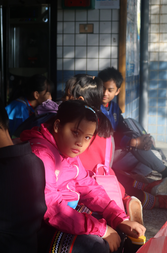

























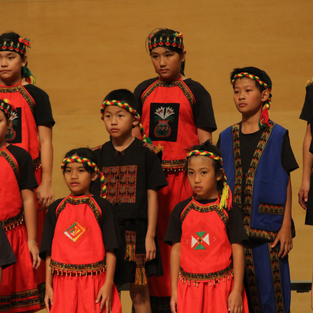





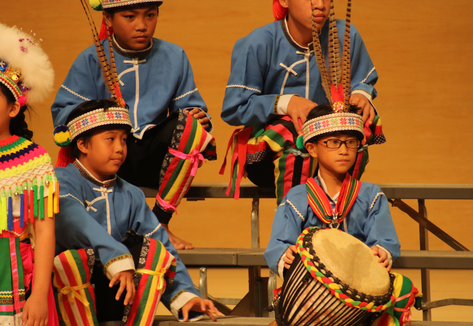





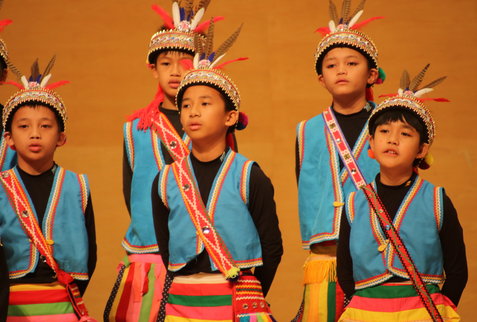

















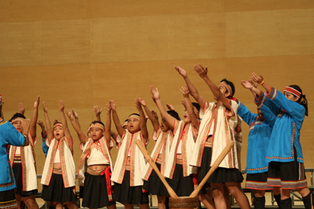























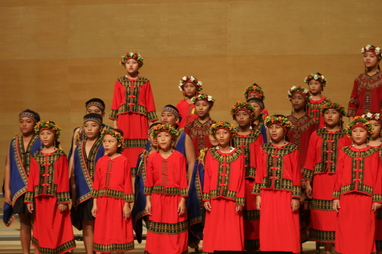









Comments